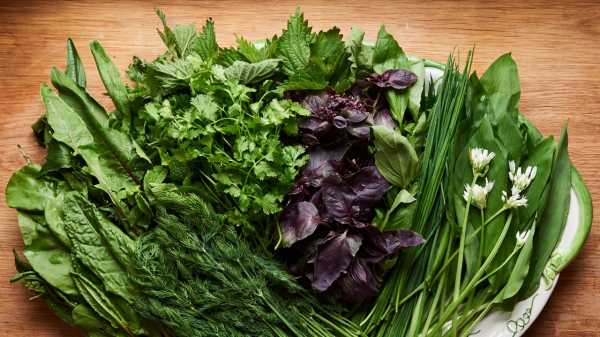
On a whim one July morning in 1987, my family set off from our small town in south Ukraine in a stuffy old Lada. We drove through Crimea, then rode by ferry to Sochi, and then drove again through Abkhazia and Georgia into Azerbaijan, where our Ukrainian-Armenian extended family lived. My mum recently reminisced about that trip, how we enjoyed late-evening dinners on our relatives’ terrace. There were tandyr-baked flatbreads, katyk yogurt, grilled meats—the works. But what stood out to mum were the herbs. At each meal, a huge platter stood proud in the middle of the table, piled with bunches of greenery: raikhan (purple basil), mint, dill, tarragon, land cress, cilantro, and spring onions. They were long and robust, nothing like those sad, weedy clumps we now buy in supermarkets, and were meant to be eaten by the stalkful, as if they were vegetables. The adults—I was too young then to have a taste for herbs—would pick up a few sprigs of each, fold them in two, dip them into salt, and chomp on them along with fresh radishes and cucumbers, sometimes folded into lavash like a veggie kebab sandwich.
Back at home in Ukraine, my family eagerly incorporated this practice into our Soviet cooking traditions. As far back as I can remember, we have always had a herb platter on the table, especially as an accompaniment to grilled meats—there is nothing like a bite of cilantro or dill to cut through the richness of fatty pork neck. But it is among the people of the Caucasus and Central Asia where aromatics are king. Many years after that family trip, I visited a friend’s half-Iranian, half-Azerbaijani mother in Berlin. Her name was Golnar, and she served us a proper Persian feast: slow-cooked buffalo with sumac chicken tahchin, saffron tahdig, and tahdig with berries and spices; herb, walnut, and barberry kudu sabzi, yogurt with spearmint and rose, and homemade litteh. And lots and lots of herbs. Golnar described them as an indispensable Persian tradition that made her feel close to her garden, and, therefore, to nature. “When you eat rose leaves and you feel their scent, all of your senses are tantalized by the flavors,” she said. “You feel enlightened, it empowers you, gives you strength. And it’s the same with all those aromatic herbs. This is why cooking Persian food is such a joy.”
Golnar’s table was filled with young people that night, about twelve of us altogether. We stripped the herb leaves off their stems—basil, mint, tarragon, dill, and cilantro—and ate them with the saucy buffalo stew and lavash and myriad dips. The next morning, I found Golnar in the kitchen with the bare herb stems salvaged from the dinner table. “I eat the stems as well!” she said. “But the young ones leave them behind.” She then scrunched the stems in her fists, to bruise them and release their scent, and threw them into a stockpot, where she let them simmer to infuse a simple vegetable broth. She quickly made a batch of tiny meatballs, and tossed them into the broth as well, along with some dandelion stalks. Then she ladled a bowl for each of us. It was one of the most perfect breakfasts I’ve ever had.
I recently went back to the Caucasus region, to Georgia and Azerbaijan, to repeat my childhood journey, this time gathering research for a cookbook. I was taken to markets, and, just like my mother years before, I found myself amazed by the abundance of greenery. There were mountains of sweet-smelling herbs on every corner of the Dezerter Bazaar in Tbilisi, the Georgian capital. Azerbaijani women, I was told, are the best herb growers. Many of the bunches they sold still sported their “umbrellas”—fully flowering crowns. Cilantro came not only with its flowers but also with its young green coriander seeds, which add a punchy citrus note to tomato-and-purple-basil salad or bashed with other herbs in ajapsandali, or Georgian ratatouille.
There are other parts of the world that take their herb-eating equally seriously. When I visited my son’s father’s family in northern Thailand, in their village near Udon Thani, his uncle served us a dish of duck and rice seasoned with the bird’s velvety, rich blood. Alongside it on the table were bunches of herbs—dill, anise-scented Thai basil, cilantro, and mint—which shared the same platter as snake beans, cucumbers, and wedges of lime. Anyone who has enjoyed a bowl of Vietnamese pho knows how it is enlivened by the branches of basil and mint served on the side. But at my home in London, where herbs are mostly relegated to garnish, I sometimes wonder why more people don’t use them to their full potential. Many herbs grow well into the chillier months of fall. Layer them on an ornate oblong platter, and they will become the most decorative feature of any table. They will make your spreads look more plentiful and generous. They will enhance guests’ appetites and help to temper strong dishes, taming the funky whiff of garlic or the spice of chilies, freshening you up from within.
Golnar’s Herb-Stem Broth with Meatballs
Serves 4-6
Ingredients
300 grams (about 10 ounces) fresh aromatic herb stalks (tarragon, coriander, dill, basil, parsley)
2.5 liters water
4 cloves garlic, divided
2 tbsp. pomegranate molasses (optional)
100 grams (about 3.5 ounces) ground beef or lamb
a small handful dill, chopped
a small handful of tarragon, chopped
3 stalks of dandelion (or chicory, celery leaves, chard)
Salt
Directions
1. Gently bruise the stalks, then throw them into a pot of cold water. Slice half of the garlic and add that, too. Add some salt and bring water to the boil. Lower the heat and let simmer for about 10 minutes. If you have time, let the broth cool down for a while, to further infuse with the herb flavor. Then strain the stems out, reserving the liquid.
2. Mix the meat mince with salt, dill, tarragon. Chop the remaining garlic and add it to the mixture. Form meat into small balls. Bring the stock back to a boil and add the meatballs. Add the pomegranate molasses and cook for 5-8 minutes.
3. Finally, add the greens and cook for another 2 minutes, so they retain their crunch. Serve with a warm hunk of bread and more chopped fresh herbs, if you have them.
This recipe was drawn from “Kaukasis: A Culinary Journey Through Georgia, Azerbaijan & Beyond,” by Olia Hercules (Weldon Owen, 2017).
Sourse: newyorker.com






